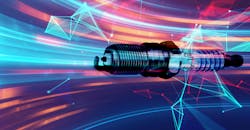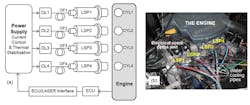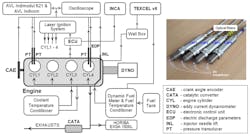Forget the Spark Plug: Use a Laser to Ignite ICE Gasoline
Despite all the attention given to electric vehicles, the venerable gasoline-based internal-combustion engine (ICE) is still very much with us, and it appears it will be for a long time. The air-fuel ignition subsystem of today for the gasoline-fueled ICE vehicle is a highly refined, computer-controlled, fuel-injected system incorporating many significant technical advances. It’s far more efficient and dynamically adaptable compared to the basic, simpler carburetor-based system with mechanical distributor and fixed ignition timing that was standard not that many years ago. Nonetheless, additional tangible gains are possible with a radically different approach that uses laser ignition (LI) instead of the conventional electric spark plug (ESP) technique.
Why even consider a laser spark plug (LSP) and laser ignition? The LSP eliminates the need for the protruding electrode of the regular spark plug, thus enhancing the combustion area. Also, the laser’s energy can be directed at different locations in the cylinder to ignite the gas-air mixture, which may future improve performance. Finally, multiple laser beams are able to be directed into the cylinder for more complete combustion.
To demonstrate this, a research team composed of three Romanian organizations has configured and tested a standard Renault engine using laser ignition, achieving improvements in fuel efficiency as well as reduction in exhaust pollutants (Fig. 1). Each laser-based “spark plug” consisted of an 807-µm laser-diode source that then “pumped” a laser for increased output power. The pumping action used 250-µs pump-pulse duration with a repetition rate of about 100 Hz. The final output was coupled to the engine cylinder via a 600-µm optical fiber.
1. Block diagram of the experimental setup, including the diode laser (DL), optical fiber (OF), laser spark plug (LSP), engine cylinder (CYL), and electronic control unit (ECU) (a). The engine equipped with the laser-ignition system (b).
The overall arrangement delivered 4-mJ pulses at 1.06 µm wavelength and 0.8-ns width to the cylinder. For the laser energy to reach within the cylinder, each was fitted with a sapphire window attached with special epoxy adhesive. The adhesive could withstand operating temperatures from −70 to +170°C. The laser beam was focused inside each cylinder at the same location where a conventional ESP creates its spark.
2. Schematic of the engine test bench; the inset shows the four LSP devices.
The arrangement was tested under two fuel conditions on a four-stroke, four-cylinder, multipoint fuel-injection gasoline passenger car engine having a standard 30 mJ ESP versus the LSP arrangement (Fig. 2). Using a stoichiometric air-fuel ratio (λ~1) indicating no unburned fuel or air, the LSP approach yielded nearly an 8% increased in engine brake power, a 7.5% reduction in brake-specific fuel consumption (BSFC), and a 20% reduction in carbon-monoxide (CO) emissions (Fig. 3). With a lean, non-stoichiometric air-fuel ratio (λ~1.25) that leaves unburned air after combustion, the corresponding numbers were 29% increase in engine brake power, 21% decrease in BSFC, and 30% CO reduction.
3. Shown are plots for the engine brake power (a) and the engine BSFC versus ignition timing (b) at an engine speed of 2000 rpm and brake mean effective pressure (BMEP) = 2 bar at air-fuel ratios (λ) of λ~1 and λ~1.25. The lines represent data fitted using polynomial functions.
The development of this LI system was done by a team comprising Romanian-based researchers from the National Institute for Laser, Plasma, and Radiation Physics, the Renault Technologie Roumanie, and the University Politehnica of Bucharest. Their Optics Express paper “On the improvement by laser ignition of the performances of a passenger car gasoline engine” provides full details of the laser-based electro-optical design, along with performance graphs and analysis of the above-cited metrics and many others.




